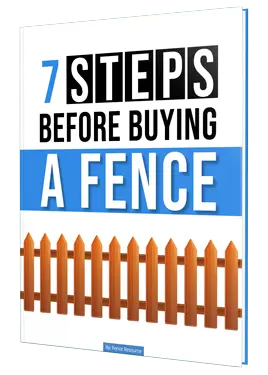What is Chain Link Fence?
Chain link fence is one of the most popular types fence. A combination of steel posts and top rail, called “framework” and “fabric”, the individual strands of wire, are woven together into a diamond pattern.
Other components called “fittings” attach the fabric to the framework and allows each line of chain link fencing to start and stop.
Cyclone fence or Hurricane fence are common names also referring to chain link fence.
A popular choice of homeowners looking to fence in their yard because of its versatility and affordability. Businesses looking to provide security also choose to go with chain link fence.
Endless configurations of height, color and grade, make it clear to see why chain link fence is the most widely used fence in the industry.
Chain Link Fence Uses
Chain link fence is used for many applications. Securing pets and children and swimming pool fences are most the common residential uses. Furthermore, added security to keep others out or to meet building codes when installing a swimming pool are other uses.
Commercial and construction applications for chain link fence are endless too. Small projects consist of things like dumpster enclosures or well head enclosures. Larger projects like schools and sports complexes are common places you’d find chain link fences.
Even the largest of facilities like airports and large factories use chain link fence for perimeter security. Just look around. You’ll see chain link fencing being used for one thing or another.
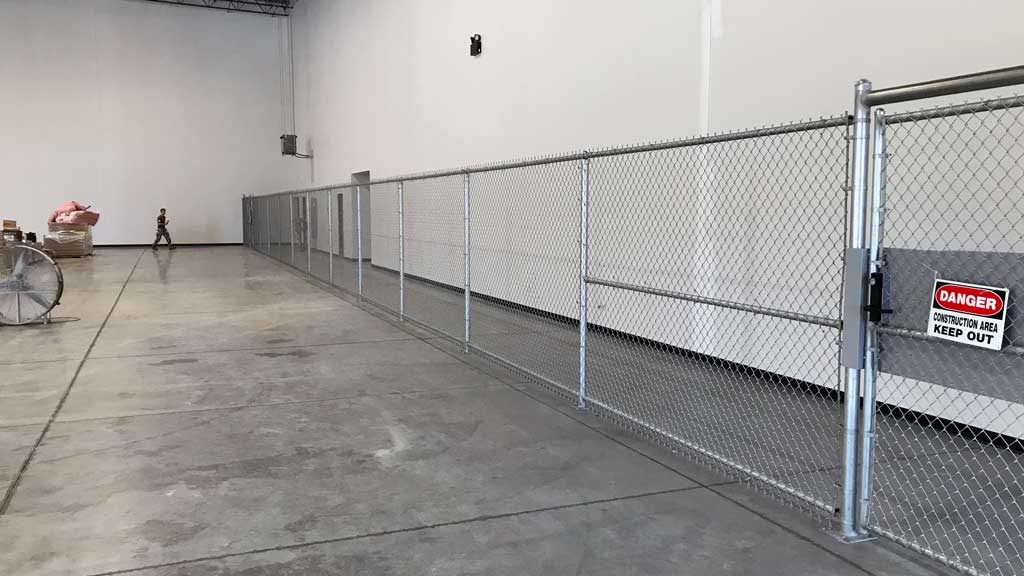
What Heights Does Chain Link Fencing Come In?
Chain link fences comes in many different heights. Manufacturers offer heights starting at 3′ tall and can build custom heights up to 20′ tall.
Standard sizes increase in one foot increments until the 8′ tall height. After that, the heights of fabric start jumping by 2′ increments.
Any fence manufacturer can make custom heights if a project calls for it. Custom height orders usually have setup fees associated with them. Sometimes, minimum total linear footage amounts also apply.
What Color Does Chain Link Fence Come In?
When you think of a chain link fence, you probably envision a silver or gray color. However, did you know chain link fencing comes in other colors too?
Green, Black, Brown and White are standard colors. Furthermore, manufacturers can color match the color of their material giving you the option to choose custom colors for special projects.
Just like the custom heights, custom colors will have setup fees from the manufacture effecting the chain link fence cost. However, most consumers stick with the standard ones.
Galvanized or Silver
The gray or silver color on chain link fencing comes from the coating that covers the metal. Galvanized is the most popular coating. It helps protect against the elements, preventing the metal from rusting.
Like most metals exposed to the elements, it will oxidize. The shininess fades after a few years, as a result turning into the dull gray color you are probably use to seeing.
Sometimes, galvanized coatings don’t meet requirements. So manufactures offer an aluminized coating as an alternative. Having the same color to the untrained eye, most wouldn’t be able to tell a difference.
Aluminized coating provide better resistance to the elements. Used in situations in areas where chemicals might be in the air, as a result causing faster corrosion. Another place you’ll find aluminized fabric is next to roadways where road slat spray during the winter can be heavy.
Black, Green and Brown
Some homeowners don’t like the industrial look of silver chain link fencing in their yards, therefore manufacturers offer colors. These darker colors blend in well with their surroundings as a result making them less noticeable.
They are more pleasing to the eye when compared to a galvanized fence. Hunter green, black, and a chocolate brown are the standard colors.
Manufacturers use the same galvanized steel fence posts and fabric as standard galvanized fence, but coat them with a vinyl product or powder coating. Therefore, providing the color.
Colors cost more than standard galvanized fencing. However, in order to get a approved for a fence permit, many cities require choosing a color other than the galvanized coating.
There is a combination of the two color options. Vinyl coated fabric attached to galvanized framework. This allows for most of the surface area to have a color while keeping the cost down as a result of using the galvanized framework.
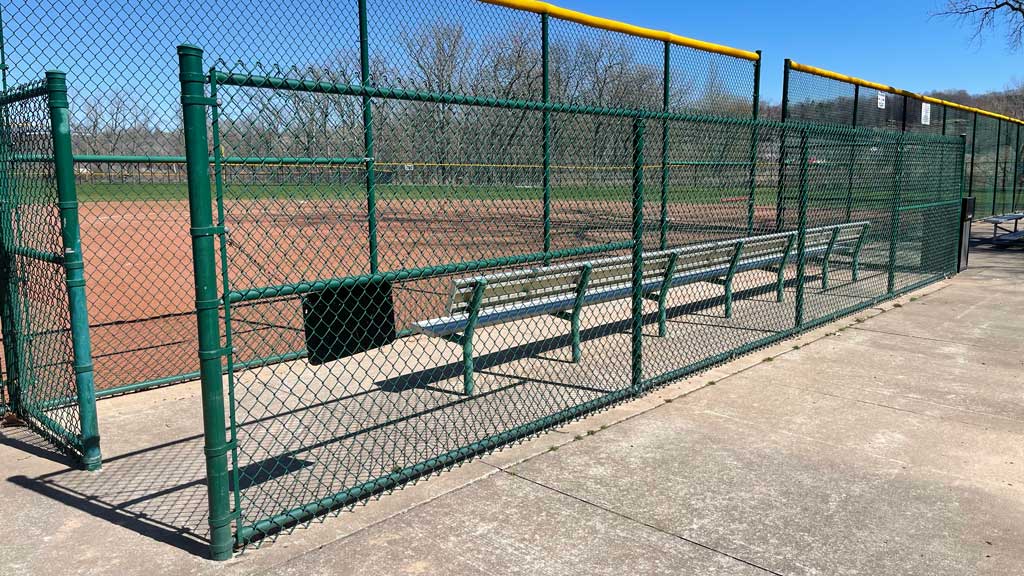
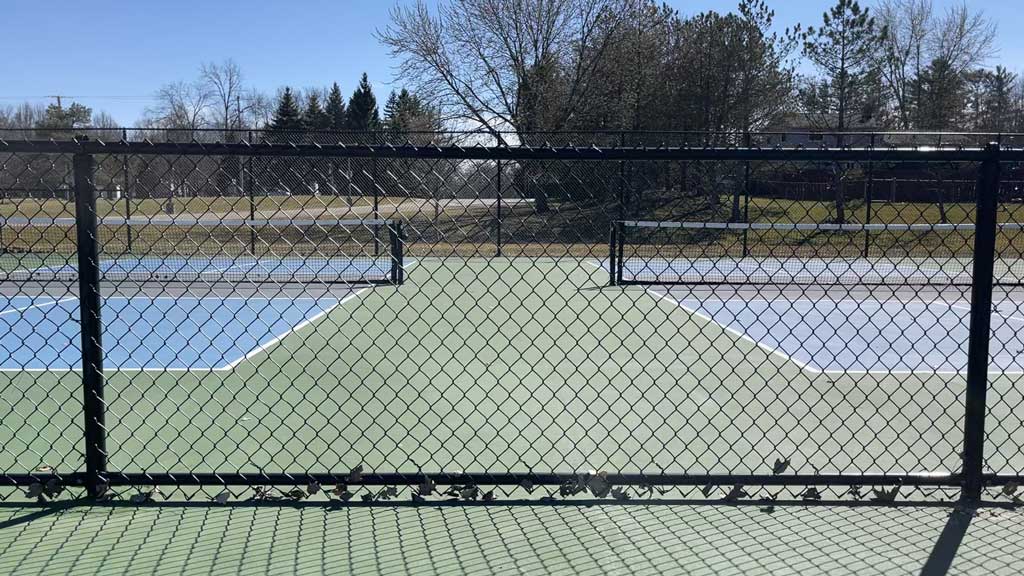
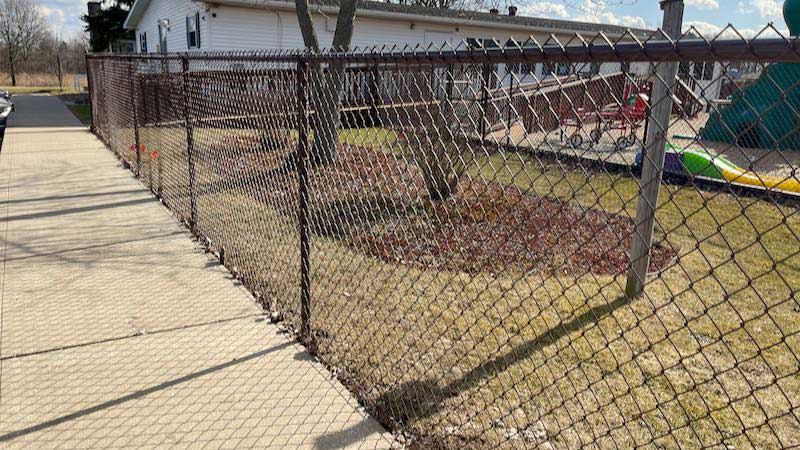
Does Chain Link Fence Come in Different Grades?
Yes! There are three grades of chain link fencing. Residential, Commercial and Industrial grade.
What makes each grade different? Two components determine the grade.
The “gauge” or thickness of the wire used to make the fabric. And the size of the framework used to construct the fencing. This includes the diameter and the wall thickness of the pipe.
Wire Fabric Gauge
Chain link fabric comes in different gauges. The thickness of each strand of wire determines the gauge. The smaller the gauge number, the heavier and stronger it will be.
For example: Chain link fence fabric constructed from 9 gauge wire is stronger than fabric constructed from 11 gauge wire.
Residential fences have fabric gauges of 11.5 to 9. Commercial grade fences use 8-9 gauge wire.
Industrial chain link fences can have fabric constructed from a very stout 6 gauge wire. However, 9 gauge is still the most popular size when dealing industrial grade applications.
Chain Link Fence Fabric Size
Fence fabric also comes in different sizes. The space measured between each link of wire determines mesh size. The most common is 2″ mesh. However, other sizes are available.
For special projects, small mesh sizes are available. Some woven so tightly that they only have a 3/8″ spacing between the links. Almost like chain mill you would find on a suit of armor.
Dog kennels sometimes share a common wall of fence between stalls. As a result, smaller 1″ mesh might be used. Therefore, preventing dogs from poking their noses through to the other side.
Tennis courts commonly have 1-3/4″ mesh. Only a 1/4″ smaller than standard 2″ mesh, the smaller space prevents tennis balls from getting stuck in the fence.
As a rule of thumb, the smaller the mesh size, the stronger the fabric is when comparing it to a larger mesh size of the same gauge wire.
Pipe Size Matters
The pipe size used to build the framework for chain link fencing also determines the grade of the fence. There are 3 parts to the framework.
The terminal posts, which consist of an end post, corner post, and the gate posts. The line posts are all of the intermediate posts, installed between the terminal posts. And the top rail, which is the horizontal rail running at the top of the fence.
To provide extra strength and security, an optional bottom rail can be installed. However, it is not common on residential applications.
Each component of the framework is offered in multiple diameters and wall thicknesses. The larger the diameter, the stronger the framework will be.
The wall thickness of the framework also determines how strong it will be. Let’s take a look at the most common diameters and wall thicknesses used to build chain link fence.
Top Rail Size
Chain link framework comes in many different diameters. As mention before, the larger the diameter of each pipe, the stronger overall the framework is. The most common diameters for the top rails are 1-3/8″ and 1-5/8″ diameter.
Residential projects normally use the smaller 1-3/8″ top rail on fences up to 5′ tall. Taller projects along with commercial and industrial fences will have the 1-5/8″ diameter top rail.
Most top rails will have a swedged end on one side. Allowing the next rail to sleeve inside the other. A rail sleeve is used on top rail of heavier wall thickness that do not have a swedge.
Line Post Size
Line posts are the metal posts that fall between the terminal posts. Set chain link line posts 10′ on center or closer, they provide a solid attachment point to tie the fabric and also hold the top rail in place.
Residential chain link fences have line posts of 1-5/8″ and 2″ diameter. Commercial and Industrial projects have line post size of 2″ diameter, 2-3/8″ diameter and sometimes 3″ diameter, providing extra strength for taller fences.
Terminal Fence Post Size
The terminal is the largest diameter metal post. Its job is to hold the tension of the fabric with help from the top rail. Gate posts are also terminal posts.
On residential jobs, gate posts are usually the same size as the rest of the terminals. However, on commercial and industrial projects metal posts usually have larger diameters.
Residential chain link jobs will have terminal posts of 1-7/8″ diameter to 2-3/8″ diameter. Commercial and Industrial jobs have terminals posts of 2-3/8″ to 2-7/8″ diameter.
Gate post diameter depends on how tall and wide each gate leaf is. 2-7/8″ diameter is pretty standard for walk gates and smaller double gate openings on commercial and industrial jobs.
For chain link double gates covering a span larger that 10′ wide, 4″ diameter gate posts are common. For the widest gate openings 6-5/8″ or 8-5/8″ diameter posts are used.
Larger diameter fence posts help prevent gate posts from sagging or feeling springy due to the weight of the gate.
Pipe Wall Thickness
Wall thickness of the framework effects the strength and grade of fence. Three wall thicknesses most used are .065 thousandths, 20 weight and 40 weight.
Residential chain link fences most commonly use the .065 thousandths measurement. The reason being, it provides enough strength while still remaining affordable.
Commercial chain link fencing applications mostly use SS20 framework. SS20 framework is stronger than .065 residential framework, but not as heavy as the 40 weight framework.
Industrial fences will use SS40 framework. It is the strongest of the three.
There is a cost difference between the 20 and 40 weight frameworks. However, unless you are dealing with large amounts of footage, the chain link fence cost offset isn’t drastic.
Most of our clients choose the heavier 40 weight wall thickness for their commercial and industrial chain link fences. The SS40 framework offers maximum strength and longevity. As a result, places like factories, prisons and baseball fields elect to go with it.
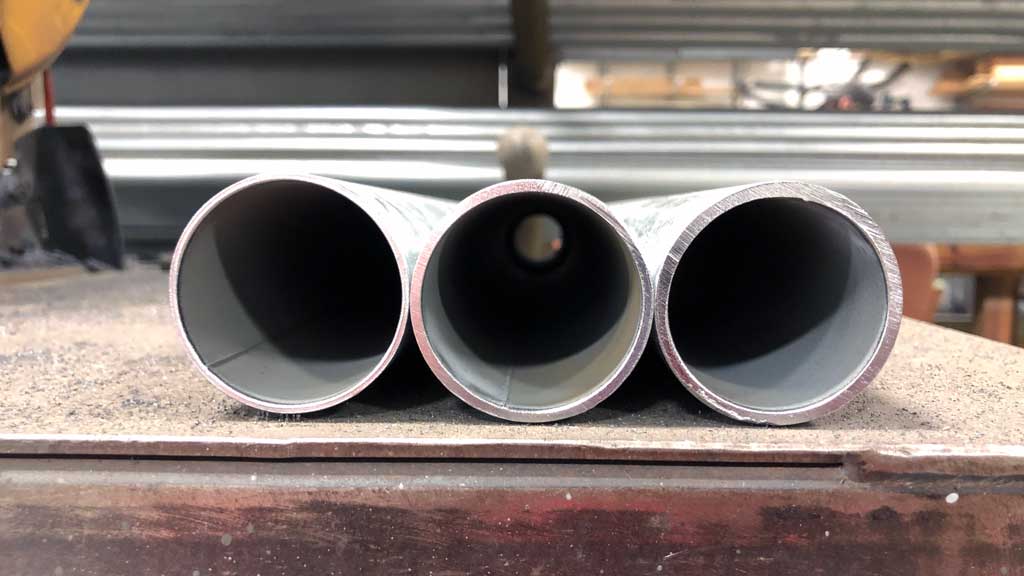
Chain Link Fence Post Size Chart
| Residential Grade | Commercial Grade | Industrial Grade | |
|---|---|---|---|
| Line Post Diameter | 1-5/8″ – 2″ Diameter | 2″ – 2-3/8″ Diameter | 2-3/8″ – 3″ Diameter |
| Terminal Post Diameter | 2″ – 2-3/8″ Diameter | 2-3/8″ – 3″ Diameter | 3″ – 4″ Diameter |
| Post Wall Thickness | .065 thousandths | SS20 | SS40 or Schedule 40 |
What About Gates?
Chances are if you are installing a new chain link fence, you will also need a gate. Gates allow for entry and exit to fenced in areas. The type and width of the gate determines how wide of an opening the gate can cover.
There are also multiple options for gate hardware. No other fence style has more options for different styles of gate hardware than chain link.
Residential Chain Link Gates
Chain link gates can be built to most widths. Walk gates are single panels called gate “leafs”. Common widths are 3,4,5 and 6 wide for walk gates. Openings larger than 6′ wide require double gates.
Double gates use two gate leafs to cover the width of the gate opening. A center post is not required. One leaf will have a sliding rod gate hardware that enters the ground in order to keep it stationary, known as a drop rod or cane bolt.
Half of the gate is used as a man gate the majority of time. When access is needed to the full width, the drop rod gate hardware pulls out of the ground and the second gate leaf swings freely.
Double gates are good for gaining access with larger pieces of equipment, trucks, or when planning on future construction. If your chain link fencing will cross a driveway, you will most certainly need a double gate.
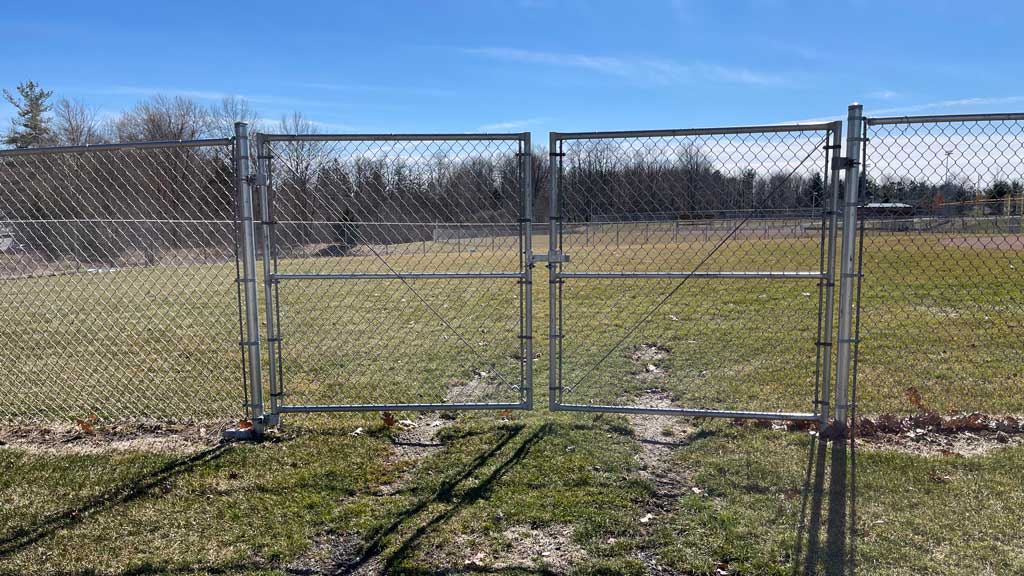
Commercial and Industrial Chain Link Gates
In commercial or industrial installations, it is not uncommon for double gates to cover spans up tp 30′ wide. Although take into consideration that you will need space for each gate leaf to open into.
If there is not enough space for a swing gate, other options are available. Cantilever gates are a type of sliding gate that roll parallel to the fence line. They take up little to no space at all.
However, the total length of a cantilever gate is 1.5 x the gate opening. This accounts for the counter balance of the gate which keeps the gate from dragging on the ground when in the closed position.
They work well in both commercial and industrial applications. Cantilever gates are best suited when space is tight or large spans needs to be covered.
Chain Link Fence Extras
There are some extra options worth mentioning to complete this article. Most of these options will be better suited for commercial or industrial applications.
However, I have seen some of them applied to residential jobs as well.
Barbed Wire
Barbed wire is a strand of wire that has little sharp pieces of wire tied to it at various increments. It is installed with 3 strands facing to one side of the fence. Normally outward. Usually angled at a 45 degree angle. However, it can also point straight up.
The “barb arm” is the cap that goes on top of the posts with the arm extended out to hold the barbed wire. Barbed wire adds one foot to the overall height of the fence.
When security is the utmost importance a 6 strand barb arm is available. This adds 3 strands of barbed wire to the inside and outside of the fence. The 6 strand variety are most commonly used at military facilities.

Razor Wire
Razor wire is a circular strand of metal forming coils attached to a chain link fencing. Sometimes referred to as razor ribbon or concertina wire.
Used for prisons or maximum security facilities, climbing or scaling a chain link fence with it is nearly impossible without sustaining serious bodily harm.
Normally installed at the top of the fence much like barbed wire. Razor wire is sometimes installed in multiple rows along the side of a fence line.
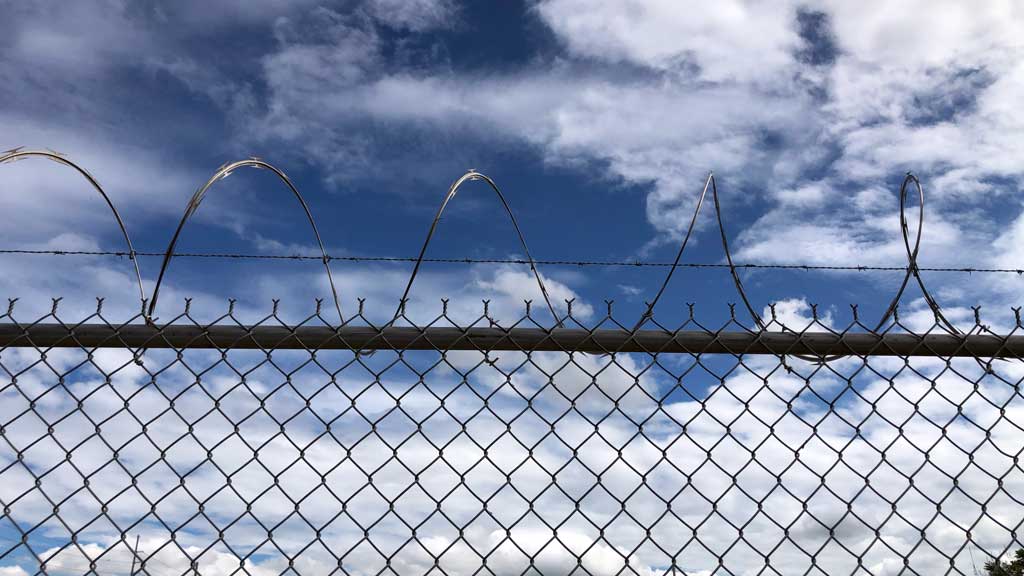
Privacy Slats
Because of its cost effectiveness and affordability, chain link fences appeal to customers. Especially in relation to other types of fences. But what if you need privacy or have to screen something off? This is where privacy slats come into play.
Privacy slats are small strips that weave in between the links of the fabric. Traditionally the strips were aluminum. Now, vinyl is the go to material.
Offering either 75% coverage with the standard privacy slat, or a winged variation that offers up to 95% coverage. Some manufactures even offer a privacy slat to look like a hedge row once installed.

Privacy Screening
Privacy screening is another method to add privacy to chain link fencing. Not as durable as a privacy slat, although more cost effective and easier to install.
Privacy screening can be semi transparent or totally opaque. Modern technologies allow the printing of signs, logo, and advertising onto chain link privacy screening transforming fence to into billboards.
Privacy screen does not take abuse from the wind and elements over extended lengths of time. It is considered more of a temporary solution to privacy.
Furthermore, is recommended that it be removed in the winters where climates are harsh or replaced every few years.
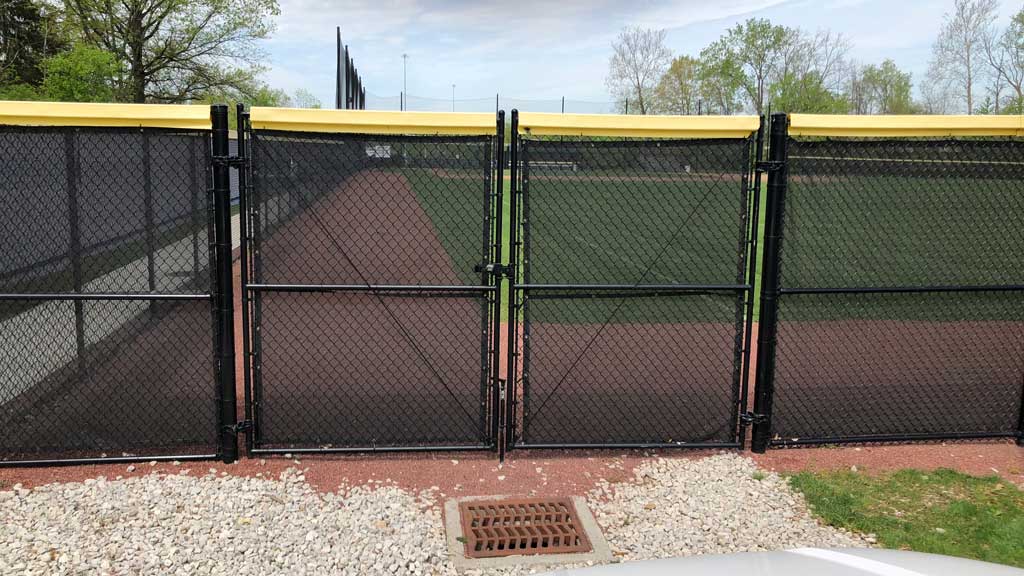
Chain Link Fence Installation
Installing a chain link fence is not a hard process. The method is the same for all of the styles and heights. However, depending on your geographic location, the methods used to install your chain link fence could vary slightly.
The steps do remain constant though. Here are the basic steps to installing a chain link fence.
Setting the Fence Posts
Every fence installation begins with setting fence posts. Chain link fence is no different. This is where you will find the biggest variance between installation methods.
In the Northeast, we concrete all of the fence posts when installing a chain link fence. The frost line will determine how deep you should set your posts. Sometimes, each city will have their own requirement.
As a rule of thumb, 24″ deep would be the minimum depth. Most of the time we are setting posts at 36″ deep. Furthermore, some cities may require a 42″ deep hole with an inspector required to approve the depth before filling the hole with concrete, called a post hole inspection.
However, in southern climates, only terminal posts are set in concrete. Line post are then driven in by hand or with a pneumatic driver.
The method of installing the line post can vary by region. One thing remains true with every chain link fence installation is posts have to go in first.
If fence posts are driven it is ok to continue to the next step in the installation. When posts are set in concrete they need time to dry before you can move to the next step.
When concreting the posts, allow a few days for the concrete to harden. I normally allow a week before stretching the fabric.
You wouldn’t want to work on the fence and have your post come out of plumb. Only to find out later when they are dried and crooked.
Stretching the Fabric
Running top rail and stretching fabric comes on day two. Installing top rail is easy. It comes in 21′ lengths and rests on top of the line posts using a guide called a loop cap.
Top rail connects to terminal posts with fittings. However, for the sake of this article, I won’t bore you with the names of each fitting used.
Next, attach the fabric to a terminal fence post. Again, more specialized fittings. Then roll it out to the opposite end.
At this point, there are a number of ways to stretch the fabric. Once stretched tight, it’s attached to the terminal post. Fence ties prevent the fabric from falling over, applied to line posts and top rail.
Small pieces of aluminum wire, fence ties connect to the fabric, wrap around the pipe, then connect (or tie) to the fabric again. Repeat this process until all lines are stretched. Fence ties are spaced between 18″ and 24″ apart.
Hanging the Chain Link Fence Gates
The last step is to hang your gates. Most installs will have at least one gate. However, some fencing installations have multiple gates including double gates.
The gates will hang between two terminal fence posts. On walk gates, one terminal post will be the hinge post and one the latch post. Double gates require both terminal post to be hinge posts.
There are infinit combinations of hinges and latches for chain link gates. Male and female hinges and fork latches are the most common. The fence is complete after the gates are hung.
In Conclusion
If you made it this far it is safe to say you are far more educated on the topic of chain link fences than you ever thought you would be. As you can see, the options and configurations are endless.
Choosing the correct framework and fabric combination can seem confusing. Using a fence professional can help to eliminate many of the options, narrowing down your search to just a few choices while estimating the chain link fencing cost.
However, homeowners and do it yourselfers can install a chain link themselves with a little work and the right tools.
Whatever way you decide, you know have the knowledge of the components, how they work together and a better understanding of the installation process.
For a more decorative fence style, checkout our aluminum fence guide!!!

